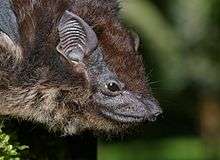Greater sac-winged bat
| Greater sac-winged bat | |
|---|---|
 | |
| Scientific classification | |
| Kingdom: | Animalia |
| Phylum: | Chordata |
| Class: | Mammalia |
| Order: | Chiroptera |
| Family: | Emballonuridae |
| Genus: | Saccopteryx |
| Species: | S. bilineata |
| Binomial name | |
| Saccopteryx bilineata (Temminck, 1838) | |
 | |
| Greater sac-winged bat range | |
The greater sac-winged bat (Saccopteryx bilineata) is a bat of the family Emballonuridae native to Central and South America.[2]
They are the most common bats seen in the rainforest, as they often roost on the outside of large trees. They are insectivores and use echolocation calls through the mouth to track their prey. The long nose and upper lip are highly mobile and can shift upward to enlarge the mouth opening.


The term "sac-winged" refers to small pouches on the wings of S. bilineata. These sacs are used by males to attract females and to mark their harem territory. During daily grooming, males will fill these sacs with drops of urine and glandular secretions. During displays for females, the male will hover in front of the female and fan her vigorously to expose her to the scent of the mixture in the wing sacs. Males will also shake the contents of the sac towards bats outside of the male's harem territory to warn off intruders.[3] Microbial fermentation in the sac may produce identifiable scent signals.[4] Sac-wing pups have been recorded vocalizing various calls and sounds in a jumbled context. For example, a female pup will give the male trill of courting followed by echolocation clicks then adult territorial challenges. These mixed-up vocalizations have been equated with human infant babbling and mispronounced songs of young birds. This is the first example of mammal babbling outside of the primate order.[5]
References
- ↑ Sampaio, E.; Lim, B.; Peters, S.; Miller, B.; Cuarón, A. D. & de Grammont, P. C. (2008). "Saccopteryx bilineata". IUCN Red List of Threatened Species. Version 2010.4. International Union for Conservation of Nature. Retrieved 2 April 2011.
- ↑ Simmons, N.B. (2005). "Order Chiroptera". In Wilson, D.E.; Reeder, D.M. Mammal Species of the World: A Taxonomic and Geographic Reference (3rd ed.). Johns Hopkins University Press. p. 390. ISBN 978-0-8018-8221-0. OCLC 62265494.
- ↑ Voigt, CC; von Helversen, O (December 1999). "Storage and display of odour by male Saccopteryx bilineata (Chiroptera, Emballonuridae)". Behavioral Ecology and Sociobiology. 47: 29–40. doi:10.1007/s002650050646.
- ↑ Voigt, C. C.; Caspers, B.; Speck, S. (2005). "Bats, Bacteria, and Bat Smell: Sex-Specific Diversity of Microbes in a Sexually Selected Scent Organ". Journal of Mammalogy. 86 (4): 745. doi:10.1644/1545-1542(2005)086[0745:BBABSS]2.0.CO;2. ISSN 1545-1542. pdf
- ↑ Knornschild, M; Behr O; von Helversen O (September 2006). "Babbling behavior in the sac-winged bat (Saccopteryx bilineata)". Naturwissenschaften. 93 (9): 451–4. doi:10.1007/s00114-006-0127-9. PMID 16736178.
